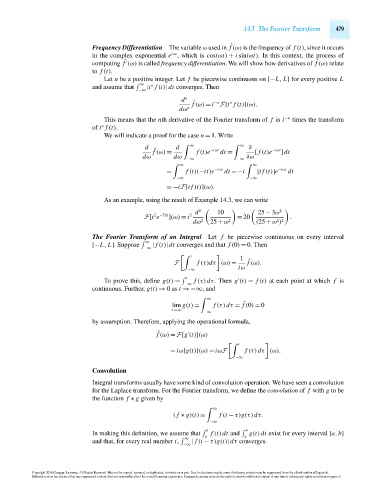Page 499 - Advanced engineering mathematics
P. 499
14.3 The Fourier Transform 479
Frequency Differentiation The variable ω used in f (ω) is the frequency of f (t), since it occurs
ˆ
iωt
in the complex exponential e , which is cos(ωt) + i sin(ωt). In this context, the process of
ˆ
computing f (ω) is called frequency differentiation. We will show how derivatives of f (ω) relate
ˆ
to f (t).
Let n be a positive integer. Let f be piecewise continuous on [−L, L] for every positive L
∞ n
and assume that |t f (t)|dt converges. Then
−∞
d n −n n
f (ω) = i F[t f (t)](ω).
ˆ
dω n
This means that the nth derivative of the Fourier transform of f is i −n times the transform
n
of t f (t).
We will indicate a proof for the case n = 1. Write
d d ∞ −iωt ∞ ∂ −iωt
ˆ
f (ω) = f (t)e dt = [ f (t)e ]dt
dω dω −∞ ∂ω
−∞
∞ ∞
= f (t)(−it)e −iωt dt =−i [tf (t)]e −iωt dt
−∞ −∞
=−iF[tf (t)](ω).
As an example, using the result of Example 14.3, we can write
d 2 10 25 − 3ω 2
2 −5|t|
F[t e ](ω) = i 2 = 20 .
2 2
dω 2 25 + ω 2 (25 + ω )
The Fourier Transform of an Integral Let f be piecewise continuous on every interval
∞
[−L, L]. Suppose | f (t)|dt converges and that f (0) = 0. Then
−∞
t
1
ˆ
F f (τ)dτ (ω) = f (ω).
iω
−∞
t
To prove this, define g(t) = f (τ)dτ. Then g (t) = f (t) at each point at which f is
−∞
continuous. Further, g(t) → 0as t →−∞, and
∞
ˆ
lim g(t) = f (τ)dτ = f (0) = 0
t→∞
−∞
by assumption. Therefore, applying the operational formula,
ˆ
f (ω) = F[g (t)](ω)
t
= iω[g(t)](ω) = iωF f (τ)dτ (ω).
−∞
Convolution
Integral transforms usually have some kind of convolution operation. We have seen a convolution
for the Laplace transform. For the Fourier transform, we define the convolution of f with g to be
the function f ∗ g given by
∞
( f ∗ g)(t) = f (t − τ)g(τ)dτ.
−∞
b b
In making this definition, we assume that f (t)dt and g(t)dt exist for every interval [a,b]
∞ a a
and that, for every real number t, | f (t − τ)g(t)|dτ converges.
−∞
Copyright 2010 Cengage Learning. All Rights Reserved. May not be copied, scanned, or duplicated, in whole or in part. Due to electronic rights, some third party content may be suppressed from the eBook and/or eChapter(s).
Editorial review has deemed that any suppressed content does not materially affect the overall learning experience. Cengage Learning reserves the right to remove additional content at any time if subsequent rights restrictions require it.
October 14, 2010 16:43 THM/NEIL Page-479 27410_14_ch14_p465-504

